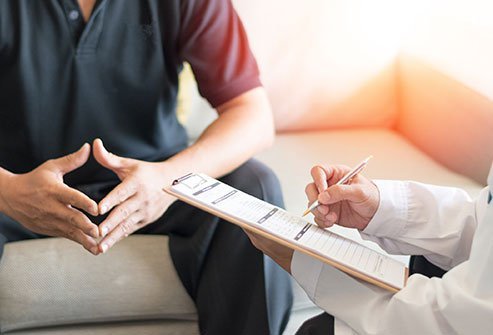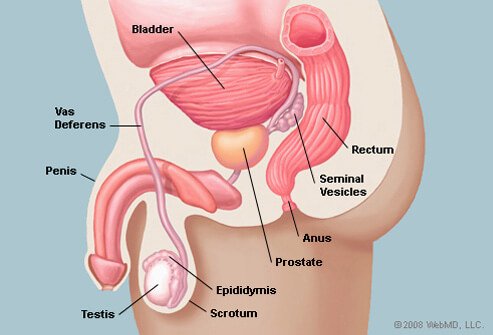Things to know about prostate problems*

Common prostate problems are prostatitis, enlarged prostate, and prostate cancer.
*Prostate problems facts medical author: Charles Patrick Davis, MD, PhD
- The prostate is a gland that is a part of the male reproductive system that wraps around the male urethra near the bladder.
- The gland is about the size of a walnut and grows larger as you age.
- Enlargement of the prostate gland can cause symptoms, for example:
- Dribbling urine
- Pain or burning during urination
- Frequent urination
- Blood in the semen or urine
- Frequent pain or stiffness in the lower back, hips, pelvic or rectal area, or the upper thighs
- Urinary incontinence (the inability to urinate)
- Painful ejaculation
- Common prostate problems in men include:
- To diagnose the cause of the prostate problem, the doctor will do a rectal exam, patient history and take bacterial cultures if the infection is suspected, and rule out prostate cancer.
- Prostate cancer is common in men over 50, especially in African Americans and in men who eat fatty food and/or have a father or brother with prostate cancer.
- Initial procedures and tests to diagnose prostate cancer may include:
- A rectal exam
- Ultrasound
- Assessment of prostate-specific antigen (PSA) levels
- Prostate cancer is definitively diagnosed by a tissue biopsy.
- Treatments for prostate cancer may include:
- Many, but not all, doctors believe that men under the age of 75 should have yearly PSA tests.
- Identifying prostate problems early is a way to reduce future prostate problems.

Prostate Problem Symptoms
Signs of enlarged prostate
The prostate is a gland that is part of the male reproductive system and is located between the bladder and penis.
Benign prostatic hyperplasia, also called enlarged prostate or BPH, is a common prostate problem. Symptoms of enlarged prostate include:
- frequent urination,
- difficulty urinating, and
- inability to urinate.
What is the prostate gland?
The prostate is a gland about the size of a walnut. It is part of the male reproductive system and wraps around the tube that carries urine out of the bladder. It grows larger as you get older. If your prostate gets too large, it can cause health issues. Having prostate problems does not always mean you have cancer.
Sometimes a doctor may find a problem during a routine checkup or by doing a rectal exam. If you think there is something wrong with your prostate, see your doctor right away.
What are common prostate problems? What are the warning signs?
Here are some examples of non-cancer prostate problems:
Benign prostatic hyperplasia, or BPH, means your prostate is enlarged but is not cancerous. It is very common in older men. An enlarged prostate may make it very difficult to urinate or cause dribbling after you urinate. You may feel the need to urinate a lot, often at night. See your family doctor for an exam. Treatments for BPH include:
- Watchful waiting is also called active surveillance. If your symptoms are not too bad, your doctor may tell you to wait before starting any treatment to see if the problem gets worse. Your doctor will tell you how often you need to return for checkups. You can start treatment later if your symptoms worsen.
- Medications. There are medicines that can help shrink the prostate or help relax muscles near your prostate to ease your symptoms. Talk with your doctor about possible side effects.
- Surgery. If nothing else has worked, your doctor may suggest surgery to help urine flow. There are many types of BPH surgery. Talk with your doctor about the risks. Regular checkups are important after surgery.
- Other treatments. Sometimes radio waves, microwaves, or lasers are used to treat urinary problems caused by BPH. These methods use different kinds of heat to reduce extra prostate tissue.
Acute bacterial prostatitis usually starts suddenly from a bacterial infection. It can cause fever, chills, or pain. It might hurt when you urinate, or you may see blood in your urine. See your doctor right away. He or she can prescribe medicine to make you feel better.
Chronic bacterial prostatitis is an infection that comes back again and again. This is a rare problem that can be hard to treat. Sometimes taking antibiotics for a long time may work. Talk with your doctor about other things you can do to help you feel better.
Chronic prostatitis, also called Chronic Pelvic Pain Syndrome (CPPS), is a common prostate problem. It can cause pain in the lower back, in the groin area, or at the tip of the penis. Men with this problem often have painful ejaculation. They may feel the need to urinate frequently, but pass only a small amount of urine. Treating this condition may require a combination of medicines, surgery, and lifestyle changes.

SLIDESHOW
Erectile Dysfunction (ED) Causes and Treatment See Slideshow
What is PSA testing?
Some doctors think that men younger than 75 should have yearly PSA tests; others do not. Not all prostate cancers are life-threatening, and treatments can cause side effects. Sometimes high PSA levels can be caused by infections, BPH, or small cancers that may not grow or spread. Your doctor may prefer “watchful waiting” until there are signs that treatment is needed. Researchers are studying ways to improve the PSA test so that it detects only cancers that need treatment.
What is prostate cancer?
Prostate cancer is common among American men. Your chance of getting prostate cancer may be affected by your:
- Age. Men age 50 and older run a greater risk.
- Race. Prostate cancer is most common among African-American men.
- Family history. If your father or brother has had prostate cancer, you are more likely to have it, too.
- Diet. Eating high-fat food with few fruits and vegetables may raise your risk.
Latest Men’s Health News
Daily Health News
Trending on MedicineNet
How is prostate cancer diagnosed?
At the start, prostate cancer does not cause symptoms. As cancer grows, you may have trouble urinating. Some men need to urinate often, especially at night. Others have pain or burning during urination, blood in the urine or semen, pain in the back, hips, or pelvis, and painful ejaculation.
To find out if these symptoms are caused by prostate cancer, your doctor will ask about your past medical problems and your family’s medical history. He or she will perform a physical exam. During the exam, your doctor will put a gloved finger into your rectum to feel your prostate for hard or lumpy areas.
Your doctor may also do a blood test to check the prostate-specific antigen (PSA) level. PSA levels can be high in men with an enlarged prostate gland or with prostate cancer. You may also need an ultrasound exam that takes computer pictures of the prostate.
If tests show that you might have cancer, your doctor will want to confirm this with a biopsy. He or she will take out tiny pieces of the prostate to look for cancer cells. Your doctor may want to do a biopsy again to re-check the results.

IMAGES
Prostate Problems Symptoms and Signs See a medical illustration of the prostate plus our entire medical gallery of human anatomy and physiology See Images
What is the treatment for prostate cancer?
Treatment for prostate cancer depends on whether cancer is in part or all of the prostate or if it has spread to other parts of the body. It also depends on your age and overall health. Talk with your doctor about the best treatment choice for you. You may want to ask another doctor for a second opinion.
For cancer that has not spread from the prostate to other parts of the body, your doctor may suggest:
- Watchful Waiting or Active Surveillance. If the cancer is growing slowly and not causing problems, you may decide not to treat it right away. Instead, your doctor will check regularly for changes in your condition.
- Surgery. The most common type of surgery removes the whole prostate and some nearby tissue. As with any surgery, there are risks. Talk to your doctor about problems that may result from surgery.
- Radiation Therapy. This treatment uses radiation to kill cancer cells and shrink tumors. The radiation may come from an x-ray machine or from tiny radioactive seeds placed inside or near the tumor. Talk with your doctor about possible side effects.
- Hormone Therapy. Men having other treatments like radiation therapy may also be treated with drugs to stop the body from making testosterone. This is done if it seems likely that cancer will come back. Hormone therapy can also be used for prostate cancer that has spread beyond the prostate.
Get more details on treatment choices for prostate cancer by calling the National Cancer Institute’s Cancer Information Service at 1-800-422-6237. Or, visit their website at www.cancer.gov/prostate.
Subscribe to MedicineNet’s Men’s Health Newsletter
By clicking “Submit,” I agree to the MedicineNet Terms and Conditions and Privacy Policy. I also agree to receive emails from MedicineNet and I understand that I may opt out of MedicineNet subscriptions at any time.
How can you protect yourself against prostate problems?
Remember that the following can be signs of a prostate problem:
- Frequent urge to urinate
- Need to get up many times during the night to urinate
- Blood in urine or semen
- Painful or burning urination
- Not being able to urinate
- Painful ejaculation
- Frequent pain or stiffness in the lower back, hips, pelvic or rectal area, or upper thighs
- Dribbling of urine
If you have any of these symptoms, see your doctor right away.
Where can I get more information about prostate problems?
Here are some helpful resources:
Agency for Healthcare Research and Quality Publications Clearinghouse
P.O. Box 8547
Silver Spring, MD 20907-8547
1-800-358-9295 (toll-free)
1-888-586-6340 (TDD/toll-free)
www.ahrq.gov
American Cancer Society
1-800-227-2345 (toll-free)
1-866-228-4327 (TTY/toll-free)
www.cancer.org
American Urological Association Foundation
1000 Corporate Boulevard
Linthicum, MD 21090
1-800-828-7866 (toll-free)
www.urologyhealth.org
National Cancer Institute Cancer Information Service
1-800-422-6237 (toll-free)
www.cancer.gov/prostate
National Kidney and Urologic Diseases Information Clearinghouse
3 Information Way
Bethesda, MD 20892-3580
1-800-891-5390 (toll-free)
1-866-569-1162 (TTY/toll-free)
www.kidney.niddk.nih.gov
For more information on health and aging, contact:
National Institute on Aging Information Center
P.O. Box 8057
Gaithersburg, MD 20898-8057
1-800-222-2225 (toll-free)
1-800-222-4225 (TTY/toll-free)
www.nia.nih.gov/health
www.nia.nih.gov/espanol
To sign up for regular email alerts about new publications and other information from the NIA, go to www.nia.nih.gov/health.
Visit www.nihseniorhealth.gov, a senior-friendly website from the National Institute on Aging and the National Library of Medicine. This website has health and wellness information for older adults. Special features make it simple to use. For example, you can click on a button to make the type larger.
From 
Men’s Health Resources
Featured Centers
Health Solutions From Our Sponsors
Medically Reviewed on 7/21/2022
References
SOURCE: “Prostate Problems.” National Institute on Aging. NIH. Updated: Jul 01, 2016.
<https://www.nia.nih.gov/health/prostate-problems>